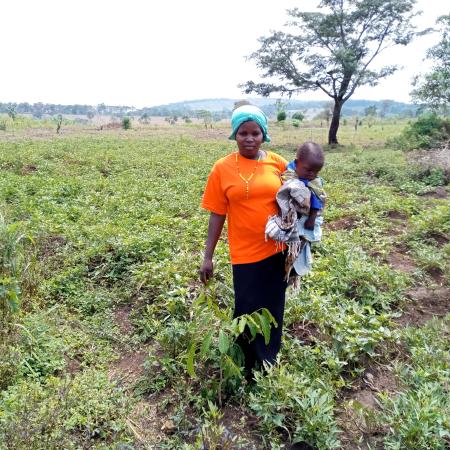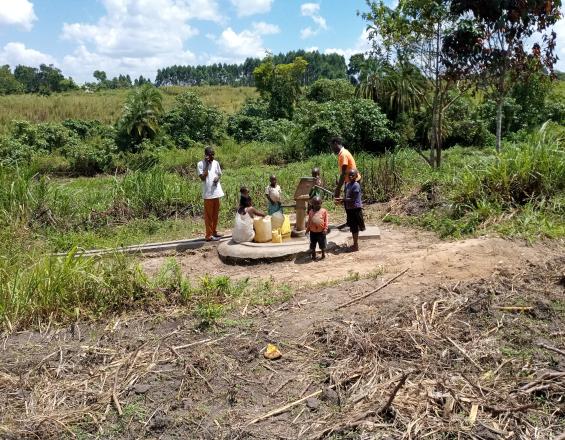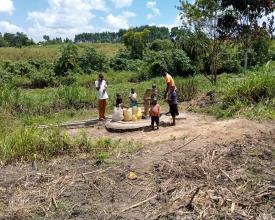
Establishement of Kayirabwa Chimpanzee Conservancy for conservation and protection of wildlife migratory routes in northern Albertine rift forests, western Uganda

Establishment of Kayirabwa Chimpanzee Conservancy from 500 privately owned forests to establish wildlife migratory routes to small and medium sized mammals and birds living in larger protected forest blocks at the edge of lake Albert, Uganda
Context
Challenges addressed
- Increased crop raiding by Chimpanzee including uprooting banana suckers, eating up ripe brew bananas and drinking local brew (in preparation) as their natural foods have been seriously reduced. These form easy baits for mass poisoning of the chimpanzees
- Chimpanzees face more harassment by communities as encounters with humans along roads and paths; wells and gardens are becoming more common
- Chimpanzees have changed their behaviours including nesting whereby it is reported that some build their nests near people’s homes
- Chimpanzees pose a potential threat to humans especially children as they have attacked children in a few incidents reported.
- Inadequate monitoring and no research
- Inadequate financial support
- Oil and gas exploration, oil roads construction
Location
Process
Summary of the process
Local partnership is needed for joint implementation of on-the ground actions such as providing alternative livelihoods to 500 land owners. The priorities for funding and implementation will be contained in a management plan developed in a participatory and consultative manner.
Building Blocks
Establishement of Kayirabwa Chimpanzee Conservancy for conservation and protection of wildlife migratory routes in northern Albertine rift forests, western Uganda
Engagement of 500 private forest owners to set aside 6000 hectares for conservation of chimpanzee corridors
Enabling factors
- Local support for chimpanzee conservation
- Great Potential for agro-ecotourism
- Great potential for nature based enterprises eg. bee keeping
- Conducive government policies
Lesson learned
These corridor forests are disappearing quickly, however, and if these findings are not acted upon soon there will be little corridor forest left to conserve and most of these species will become extinct in this region. There is for Kayirabwa Chimpanzee Conservancy to provide economic incentives to land owners to enable these corridor forests to offset the current incentives to destroy the forest for agriculture.
Establishement of Kayirabwa Chimpanzee Conservancy for conservation and protection of wildlife migratory routes in northern Albertine rift forests, western Uganda
These corridor forests are disappearing quickly and if these findings are not acted upon soon there will be little corridor forest left to conserve and most of these species will become extinct in this region. There is a need for the Ministry of Water, Energy and the Environment, the District Environmental offices and the National Forest Authority to move ahead quickly with providing economic and financial incentives to enable these corridor forests to receive funding as soon as they can to offset the current incentives to destroy the forest for agriculture.
Enabling factors
- Presence of Kihaimira Central Forest Reserve as core area
- Local support for chimpanzee conservation
- Great Potential for agro-ecotourism
- Great potential for nature based enterprises eg. bee keeping
- Conducive government policies
Lesson learned
A corridor forests east of Lake Albert are rich in biodiversity, they contain many of the species that may require connectivity to remain viable in the larger forest blocks, and they are likely to be playing a functional role in terms of connecting meta-populations of these species. There is a need to find incentives for land owners who have forest on their land in the corridors to conserve these forests in order to maintain these functional roles.
Impacts
- A population of 150 chimpanzees residing in the corridor forests secured
- Improved harmonious relationship between local communities and natural resource managers as a result of reduced chimpanzee-human conflicts
- Increased household incomes and food security resulting from reduced incidencies of chimpanzees raiding crops
Beneficiaries
- National Forestry Authority
- Farmers living adjacent to forests
- Tourists
- Households using ecosystem services (e.g. water)
- Researchers
Story

The corridor forests on the eastern side of lake Albert are relatively rich in species and have a conservation value in terms of both species richness as well as providing the function of linking larger forest blocks and hence metapopulations of certain species that require these corridors to maintain viable populations (corridor species). Many large and medium sized mammal species still occur in the corridor forests including chimpanzees, redtail, blue monkeys, baboons, vervets and black and white colobus monkeys. Many bird species that probably require the corridors to link populations in the larger forest blocks are also found in these corridors, particularly the hornbills and tauracos. A few forest raptors were observed in the corridors but not many.

